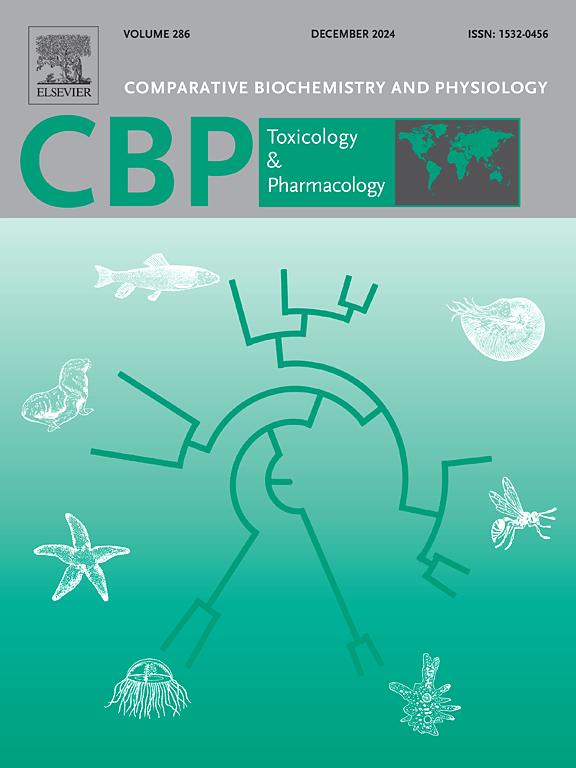Neurotoxic effects of chronic exposure to perfluorobutane sulfonate in adult zebrafish (Danio Rerio)
IF 4.3
3区 环境科学与生态学
Q2 BIOCHEMISTRY & MOLECULAR BIOLOGY
Comparative Biochemistry and Physiology C-toxicology & Pharmacology
Pub Date : 2025-02-22
DOI:10.1016/j.cbpc.2025.110162
引用次数: 0
Abstract
Per and polyfluoroalkyl substances (PFAS) are synthetic compounds extensively utilized in industrial applications and consumer products. Long-chain PFAS has been linked to negative health impacts, prompting the introduction of shorter-chain alternatives like perfluorobutane sulfonate (PFBS). While long-chain PFAS are known to induce oxidative stress, neuroinflammation, and neuronal apoptosis, the neurotoxic potential of short-chain PFAS like PFBS was not well studied. This study aims to evaluate the neurotoxic effect and bioaccumulation of PFBS on adult zebrafish. In this study, adult zebrafish were exposed to PFBS at concentrations of 0.14, 1.4, and 14 μM for 28 days. PFBS accumulation in zebrafish brain tissue was confirmed by specific mass spectrum peaks. Behavioral assays revealed significant anxiety-like behavior, with PFBS (14 μM) exposed zebrafish spending more time in the bottom zone of the novel tank diving test (179.33 ± 1.03 s) and in the light and dark preference results showed increased time spent in the dark zone (165.17 ± 10.89 s). Learning and memory deficits were evident in the T-maze test, where PFBS-exposed zebrafish spent less time in the favorable zone (0.67 ± 1.15 s). Biochemical analysis showed significant inhibition of acetylcholinesterase (AChE) activity in the male and female brains (0.06 μmol/min and 0.09 μmol/min). Antioxidant enzyme levels were reduced, with superoxide dismutase (SOD) 5.45 U/mg protein in the male brain and 4.06 U/mg protein in the female brain, leading to increased oxidative stress biomarkers like lipid peroxidation and nitric oxide levels in male (0.99 μmol/mg/ml and 8.85 μM) and female brain (1.83 μmol/mg/ml and 8.74 μM), respectively. Gene expression analysis demonstrated the downregulation of SOD, CAT, GSR, and GPx, indicating impaired antioxidant defense mechanisms. Histopathological analysis of PFBS exposure groups revealed vacuolation and increased pyknotic neurons in the optic tectum region of the brain. Our study suggests that PFBS exposure leads to bioaccumulation in the brain, causing histopathological changes and cognitive impairment. In conclusion, PFBS induces neurotoxicity which can be a potential risk as they are incorporated into a range of consumer products.

慢性接触全氟丁烷磺酸对成年斑马鱼的神经毒性影响(Danio Rerio)。
Per和多氟烷基物质(PFAS)是广泛用于工业应用和消费品的合成化合物。长链全氟磺酸与负面健康影响有关,促使全氟丁烷磺酸(PFBS)等短链替代品问世。虽然已知长链PFAS可诱导氧化应激、神经炎症和神经元凋亡,但短链PFAS如PFBS的神经毒性潜能尚未得到很好的研究。本研究旨在评估PFBS对成年斑马鱼的神经毒性作用和生物蓄积。在这项研究中,成年斑马鱼暴露于浓度为0.14、1.4和14 μM的PFBS 28 天。特异性质谱峰证实PFBS在斑马鱼脑组织中的蓄积。行为学分析显示,PFBS(14 μM)暴露的斑马鱼在新型水箱潜水测试中在底部区域停留的时间增加(179.33 ± 1.03 s),在明暗偏好结果中在黑暗区域停留的时间增加(165.17 ± 10.89 s)。在t迷宫测试中,学习和记忆缺陷很明显,暴露于pfbs的斑马鱼在有利区域停留的时间更短(0.67 ± 1.15 s)。生化分析显示,乙酰胆碱酯酶(AChE)活性在男性和女性大脑中有显著的抑制作用(0.06 μmol/min和0.09 μmol/min)。抗氧化酶水平降低,男性脑超氧化物歧化酶(SOD)蛋白含量为5.45 U/mg,女性脑超氧化物歧化酶(SOD)蛋白含量为4.06 U/mg,导致男性脑脂质过氧化和一氧化氮水平升高(分别为0.99 μmol/mg/ml和8.85 μM),女性脑脂质过氧化和一氧化氮水平分别为1.83 μmol/mg/ml和8.74 μM)。基因表达分析显示SOD、CAT、GSR和GPx下调,表明抗氧化防御机制受损。PFBS暴露组的组织病理学分析显示脑视神经顶盖区空泡化和收缩神经元增加。我们的研究表明,PFBS暴露会导致大脑生物蓄积,导致组织病理改变和认知障碍。综上所述,PFBS会引起神经毒性,这可能是一种潜在的风险,因为它们被纳入了一系列消费品中。
本文章由计算机程序翻译,如有差异,请以英文原文为准。
求助全文
约1分钟内获得全文
求助全文
来源期刊
CiteScore
7.50
自引率
5.10%
发文量
206
审稿时长
30 days
期刊介绍:
Part C: Toxicology and Pharmacology. This journal is concerned with chemical and drug action at different levels of organization, biotransformation of xenobiotics, mechanisms of toxicity, including reactive oxygen species and carcinogenesis, endocrine disruptors, natural products chemistry, and signal transduction with a molecular approach to these fields.

 求助内容:
求助内容: 应助结果提醒方式:
应助结果提醒方式:


